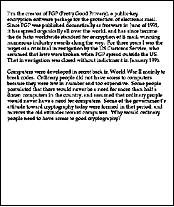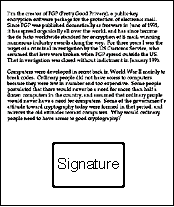What is a Digital Signature? 理解数字签名与数字证书
What is a Digital Signature?An introduction to Digital Signatures, by David Youd
 Bob |
 |
 (Bob's public key)
|
Bob has been given two keys. One of Bob's keys is called a Public Key, the other is called a Private Key.
| Bob's Co-workers: | ||||
 |
 |
 |
 |
 Anyone can get Bob's Public Key, but Bob keeps his Private Key to himself |
| Pat | Doug | Susan | ||
Bob's Public key is available to anyone who needs it, but he keeps his Private Key to himself. Keys are used to encrypt information. Encrypting information means "scrambling it up", so that only a person with the appropriate key can make it readable again. Either one of Bob's two keys can encrypt data, and the other key can decrypt that data.
Susan (shown below) can encrypt a message using Bob's Public Key. Bob uses his Private Key to decrypt the message. Any of Bob's coworkers might have access to the message Susan encrypted, but without Bob's Private Key, the data is worthless.
 |
 |
"Hey Bob, how about lunch at Taco Bell. I hear they have free refills!" |  |
HNFmsEm6Un BejhhyCGKOK JUxhiygSBCEiC 0QYIh/Hn3xgiK BcyLK1UcYiY lxx2lCFHDC/A |
 |
 |
HNFmsEm6Un BejhhyCGKOK JUxhiygSBCEiC 0QYIh/Hn3xgiK BcyLK1UcYiY lxx2lCFHDC/A |  |
"Hey Bob, how about lunch at Taco Bell. I hear they have free refills!" |
With his private key and the right software, Bob can put digital signatures on documents and other data. A digital signature is a "stamp" Bob places on the data which is unique to Bob, and is very difficult to forge. In addition, the signature assures that any changes made to the data that has been signed can not go undetected.
 |
 |
 |
 |
To sign a document, Bob's software will crunch down the data into just a few lines by a process called "hashing". These few lines are called a message digest. (It is not possible to change a message digest back into the original data from which it was created.) |
 |
 |
 |
Bob's software then encrypts the message digest with his private key. The result is the digital signature.
 |
 |
 |
Finally, Bob's software appends the digital signature to document. All of the data that was hashed has been signed.
 |
 |
 |
 |
 |
Bob now passes the document on to Pat.
 |
First, Pat's software decrypts the signature (using Bob's public key) changing it back into a message digest. If this worked, then it proves that Bob signed the document, because only Bob has his private key. Pat's software then hashes the document data into a message digest. If the message digest is the same as the message digest created when the signature was decrypted, then Pat knows that the signed data has not been changed. |
Plot complication...
 |
Doug (our disgruntled employee) wishes to deceive Pat. Doug makes sure that Pat receives a signed message and a public key that appears to belong to Bob. Unbeknownst to Pat, Doug deceitfully sent a key pair he created using Bob's name. Short of receiving Bob's public key from him in person, how can Pat be sure that Bob's public key is authentic? |
It just so happens that Susan works at the company's certificate authority center. Susan can create a digital certificate for Bob simply by signing Bob's public key as well as some information about Bob.
|
 |
  |
 |
 |
Now Bob's co-workers can check Bob's trusted certificate to make sure that his public key truly belongs to him. In fact, no one at Bob's company accepts a signature for which there does not exist a certificate generated by Susan. This gives Susan the power to revoke signatures if private keys are compromised, or no longer needed. There are even more widely accepted certificate authorities that certify Susan.
Let's say that Bob sends a signed document to Pat. To verify the signature on the document, Pat's software first uses Susan's (the certificate authority's) public key to check the signature on Bob's certificate. Successful de-encryption of the certificate proves that Susan created it. After the certificate is de-encrypted, Pat's software can check if Bob is in good standing with the certificate authority and that all of the certificate information concerning Bob's identity has not been altered.
Pat's software then takes Bob's public key from the certificate and uses it to check Bob's signature. If Bob's public key de-encrypts the signature successfully, then Pat is assured that the signature was created using Bob's private key, for Susan has certified the matching public key. And of course, if the signature is valid, then we know that Doug didn't try to change the signed content.

Although these steps may sound complicated, they are all handled behind the scenes by Pat's user-friendly software. To verify a signature, Pat need only click on it.
(c) 1996, David Youd
Permission to change or distribute is at the discretion of the author
Warning: You may be missing a few lines of text if you print this document. This seems to occur on pages following pages that have blank space near the bottom due to moving tables with large graphics in them to the next page so that the images are not split across pages. If this happens to you, simply print out document in sections. (Ex: I have the problem on page 4, so I print pages 1-3, then pages 4-5.)
What is a Digital Signature? 理解数字签名与数字证书的更多相关文章
- 通俗理解数字签名,数字证书和https
最近在开发关于PDF合同文档电子签章的功能,大概意思就是在一份PDF合同上签名,盖章,使其具有法律效应.签章有法律效应必须满足两个条件: 能够证明签名,盖章者是谁,无法抵赖 PDF合同在签章后不能被更 ...
- 转!!通俗理解数字加密,数字签名,数字证书和https
原博文地址:https://www.jianshu.com/p/4932cb1499bf 前言 最近在开发关于PDF合同文档电子签章的功能,大概意思就是在一份PDF合同上签名,盖章,使其具有法律效应. ...
- 数字签名、数字证书的原理以及证书的获得java版
数字签名原理简介(附数字证书) 首先要了解什么叫对称加密和非对称加密,消息摘要这些知识. 1. 非对称加密 在通信双方,如果使用非对称加密,一般遵从这样的原则:公钥加密,私钥解密.同时,一般一个密钥加 ...
- 和安全有关的那些事(非对称加密、数字摘要、数字签名、数字证书、SSL、HTTPS及其他)
转自http://blog.csdn.net/bluishglc/article/details/7585965 对于一般的开发人员来说,很少需要对安全领域内的基础技术进行深入的研究,但是鉴于日常系统 ...
- 大话https演化过程(对称加密、非对称加密、公钥、私钥、数字签名、数字证书)
大话https演化过程(包括概念:对称加密.非对称加密.公钥.私钥.数字签名.数字证书.https访问全过程) 在网络上发送数据是非常不安全的,非常容易被劫持或是被篡改,所以每次定向发送数据你都可 ...
- 数字签名与数字证书以及https
数字签名与数字证书以及httpshttps://blog.csdn.net/lzghxjt/article/details/79604602
- 对称加密、非对称加密、数字签名、数字证书、SSL是什么
非对称密钥加解密 对于一份数据,通过一种算法,基于传入的密钥(一串由数字或字符组成的字符串,也称key),将明文数据转换成了不可阅读的密文,这就是“加密”,同样的,密文到达目的地后,需要再以相应的算法 ...
- 探究公钥、私钥、对称加密、非对称加密、hash加密、数字签名、数字证书、CA认证、https它们究竟是什么,它们分别解决了通信过程的哪些问题。
一.准备 1. 角色:小白.美美.小黑. 2. 剧情:小白和美美在谈恋爱:小黑对美美求而不得.心生怨念,所以从中作梗. 3. 需求:小白要与美美需通过网络进行通信,联络感情,所以必须保证通信的安全性. ...
- 公钥、私钥、数字签名、数字证书、对称与非对称算法、HTTPS
作者: yoyoso https://my.oschina.net/ioslighter/blog/359207 对公钥和私钥有点稀里糊涂的,搜索了一些资料,作一些整理吧,先看这个: 加密--公钥 看 ...
随机推荐
- Oracle系统权限与对象权限
oracle权限分为: 系统权限: 允许用户执行特定的数据库动作,如创建表.创建索引.连接实例等. 对象权限: 允许用户操纵一些特定的对象,如读取视图,可更新某些列.执行存储过程等. 系统权限 超过一 ...
- WebMvcConfigurationSupport跨域和fastjson全局替换
@Configuration public class WarnWebMvcConfigurationSupport extends WebMvcConfigurationSupport { /** ...
- 使用python的ctypes库实现内存的动态申请和释放
1.申请前内存占用情况 2.申请内存 from ctypes import * import time #在这里申请1G的内存,单位k mem = create_string_buffer(1024* ...
- python读写增删修改ini配置文件
一,百度百科 .ini 文件是Initialization File的缩写,即初始化文件,是windows的系统配置文件所采用的存储格式,统管windows的各项配置,一般用户就用windows提供的 ...
- asp.net 12 AJAX
Javascript:ajax Ajax:get <%@ Page Language="C#" AutoEventWireup="true" CodeBe ...
- EntityFramework学习要点记一
一.Entity的注解属性(Annotations)不管是code first还是db first,都需要用到注解属性,至于用System.ComponentModel.DataAnnotations ...
- mqtt协议实现 java服务端推送功能(三)项目中给多个用户推送功能
接着上一篇说,上一篇的TOPIC是写死的,然而在实际项目中要给不同用户 也就是不同的topic进行推送 所以要写活 package com.fh.controller.information.push ...
- 第二十五篇 jQuery 学习7 获取并设置 CSS 类
jQuery 学习7 获取并设置 CSS 类 jQuery动态控制页面,那么什么是动态呢?我们就说一下静态,静态几乎又纯html+css完成,就是刷新页面之后,不会再出现什么变动,一个实打实的静态 ...
- Cesium中的样条插值
Cesium中的样条插值 在cesium里,提供了三种样条插值方法,LinearSpline,CatmullRomSpline,HermiteSpline.在具体的实例上,可以使用样条插值法利用已知的 ...
- 上传图片,语音,和富文本(webuploader,dropzone, froala)
首先是上传图片,使用的百度webuploader 自己修改后可以实例化多个uploader对象: HTML: <!DOCTYPE html> <html xmlns="ht ...

